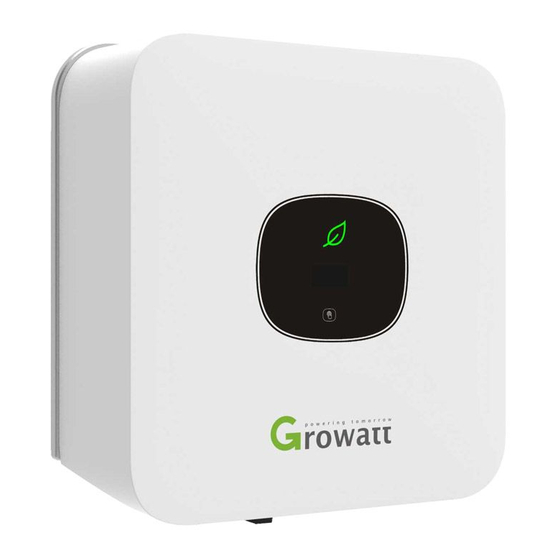
Table of Contents
Advertisement
Advertisement
Table of Contents

Summarization of Contents
Notes on this Manual
1.1 Validity
Describes the scope and applicability of the manual for Growatt Inverter models.
1.2 Target Group
Defines the intended audience as qualified personnel with relevant training and skills.
1.3 Additional Information
Provides information on where to find further details and disclaims liability for instruction failure.
1.4 Symbols and Markings
Explains warning symbols, safety icons, and product markings used throughout the document.
Safety
2.1 Intended Use
Describes the primary purpose of the unit: converting DC current to grid-compliant AC.
2.2 Qualification of Skilled Person
Details the requirements for personnel to operate and install the system safely.
2.3 Safety Instructions
Provides essential safety precautions that must be observed during installation and operation.
Safety Warnings
2.4 Assembly Warnings
Highlights safety precautions and potential hazards during the inverter's assembly and installation.
2.5 Electrical Connection Warnings
Emphasizes critical safety measures for electrical connections to prevent injury or damage.
2.6 Operation Warnings
Details safety considerations and risks associated with the inverter's operation.
Product Description
3.1 MIC TL-X Overview
Provides a visual overview of the MIC TL-X inverter, identifying its main components and ports.
3.2 Type Label Information
Explains the details and identification provided on the inverter's type label.
Product Details
3.3 Size and Weight
Presents the physical dimensions and weight specifications of the inverter models.
3.4 Storage Guidelines
Offers recommendations for appropriate storage locations and conditions for the inverter.
3.5 Unit Advantages
Lists the key features and benefits that characterize the Growatt inverter unit.
Unpacking and Inspection
4.1 Unpacking and Inspection Steps
Guides users through the process of unpacking the inverter and checking for any transport damage.
Installation Guidance
5.1 Safety Instructions
Outlines critical safety instructions to be followed during the installation process.
5.2 Installation Location Selection
Provides recommendations for selecting a suitable and safe installation location for the inverter.
Mounting the Inverter
5.3 Mounting the Inverter
Details the procedures for securely mounting the inverter onto a wall or bracket.
Electrical Connection
6.1 Electrical Safety
Highlights safety precautions related to electrical connections to prevent shock hazards.
6.2 Wiring AC Output
Provides instructions and recommendations for wiring the AC output of the inverter.
DC and PV Array Connection
6.3 Second Protective Conductor
Explains the requirement and procedure for connecting a second protective conductor.
6.4 PV Array (DC Input) Connection
Details the conditions and steps for safely connecting the PV array to the inverter.
Signal Connection
6.5 Signal Cable Connection
Provides instructions for connecting the signal cable to the inverter's 8-pin connector.
Advanced Electrical Connections
6.6 Inverter Grounding
Explains the mandatory connection of the inverter to the AC grounding conductor.
6.7 Active Power Control Setup
Details the setup for active power control using smart meters or CTs.
6.8 Demand Response Modes (DRMS)
Describes the inverter's demand response modes and their RJ45 terminal pin assignment.
Demand Response and AFCI
6.8.2 DRMS Assertion Methods
Explains methods for asserting demand response modes by shorting pins.
6.8.3 EU Power Control Interface
Details the power control interface for European regulations using RRCR.
6.9 AFCI (Optional)
Provides information on the Arc Fault Circuit Interrupter (AFCI) function and its safety.
AFCI Operation Steps
6.9.3 AFCI Operation Steps
Outlines the steps for operating the AFCI function, including shutdown and troubleshooting.
Commissioning - Start-up
7.1 Start the Inverter
Details the procedure for starting the inverter, including touch control and country setting.
Commissioning - General Settings
7.2 General Setting
Covers general settings such as display language, COM address, and date/time configuration.
Commissioning - Advanced & Communications
7.3 Advanced Setting
Details advanced settings including country reset, export limitation, and factory reset.
7.4 Communications Setup
Provides information on RS485 and USB-A communication ports for monitoring and updates.
Inverter Start-Up and Shut Down
8.1 Start-Up Procedure
Outlines the steps for starting up the inverter by connecting AC and turning on the DC switch.
8.2 Shut Down Procedure
Details the safe procedure for turning off the inverter, including disconnecting power.
Maintenance and Cleaning
9.1 Heat Dissipation Check
Guides on checking and improving heat dissipation conditions for optimal inverter performance.
9.2 Cleaning the Inverter
Provides instructions for safely cleaning the inverter's enclosure, display, and LEDs.
9.3 DC Disconnect Check
Instructs on checking the DC disconnect for visible damage and performing contact cleaning.
Trouble Shooting - Errors and System Faults
11.1 OLED Error Messages
Explains common error messages displayed on the OLED screen and required information.
11.2 System Faults
Describes system faults, their causes, and troubleshooting steps before contacting support.
Trouble Shooting - Warnings and Faults
11.3 Inverter Warnings
Lists inverter warning codes, their meanings, and suggested actions for resolution.
11.4 Inverter Faults
Details inverter fault codes, their meanings, and recommended troubleshooting steps.
Decommissioning
13.1 Dismantling the Inverter
Provides step-by-step instructions for safely dismantling the inverter.
13.2 Packing the Inverter
Offers guidance on how to properly pack the inverter for transport or storage.
13.3 Storing the Inverter
Recommends conditions for storing the inverter to maintain its integrity.
13.4 Disposing of the Inverter
Outlines the correct procedures for disposing of faulty inverters and accessories.
Technical Data - Specifications
14.1 Specifications Overview
Presents comprehensive technical specifications for various Growatt inverter models.
Technical Data - Connectors and Accessories
14.2 Connector Information
Provides details on DC and AC connector types and their compatibility.
14.3 Torque Specifications
Lists the required torque values for various screws used in the inverter assembly.
14.4 Optional Accessories
Lists optional accessories available for the Growatt inverter products.
Contact Information
Contact GROWATT Serviceline
Provides contact details and necessary information for technical support inquiries.
Compliance Certificates
List of Compliance Certificates
Lists the CE, IEC, and other standards/directives the unit complies with.
















Need help?
Do you have a question about the MIC 3300TL-X and is the answer not in the manual?
Questions and answers